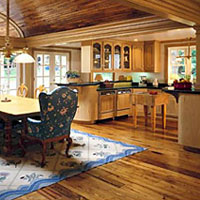Serving Upstate NY—VT—MA • For selections & prices, CALL or EMAIL US
Chestnut
Wood Flooring Species
Scientific Name:
Castanea dentata
Other Names and Species:
American Chestnut
Chinkapin
Sweet Chestnut
Origin:
North America
Appearance:
The sapwood of chestnut is white to light brown, while the heartwood is grayish-brown to brown in color. The species has a straight, sometimes spiraled grain and is fairly coarse in texture.
Properties:
Chestnut has a high resistance to decay. The wood remains smooth under friction and is reported to have no odor. Chestnut is difficult and time-consuming to dry properly.
Janka Hardness: 540
As a flooring option, chestnut is one of the softer species available. It is just under thirty percent harder than white pine, sixty percent as hard as cedar, fifty-four percent as hard as teak, just under forty-two percent as hard as red oak, roughly thirty-seven percent as hard as hard maple, about one-third as hard as wenge, and only approaches twenty-five percent that of santos mahogany’s ranking of 2200.
Workability:
Chestnut is somewhat difficult to saw properly. Pre-boring is suggested, yet the wood holds nails well once they are in place. Glue holds well with chestnut flooring. This species sands fairly well but does mar somewhat easily under heavy traffic.
Principal Uses:
The uses for chestnut include flooring, flooring accents, fine furniture, interior trim, and tables.






